Effect of Ultrafiltration of Pitaya Extract (Stenocereus thurberi) on Its Phytochemical Content, Antioxidant Capacity, and UPLC-DAD-MS Profile
Abstract
1. Introduction
2. Results and Discussion
2.1. Physico-Chemical Characterization
2.2. Phytochemical Content
2.3. Antiradical Capacity ABTS + and DPPH·
2.4. Identification of Phenolic Compounds by UPLC-DAD-MS
2.5. Correlation Analysis between Phytochemicals and Antioxidant Capacity
3. Materials and Methods
3.1. Raw Material
3.2. Reagents
3.3. Physico-Chemical Characterization
3.4. Preparation of Uncleared Extract and Clarified Extract from S. thurberi Fruits
3.5. Photometric Quantification of Betalains
3.6. Total Phenols
3.7. Antiradical Capacity Using the ABTS + Assay
3.8. Antiradical Capacity Using the DPPH· Assay
3.9. Identification of Phenolic Compounds by UPLC-DAD-MS
3.10. Statistical Analysis
4. Conclusions
Author Contributions
Funding
Acknowledgments
Conflicts of Interest
References
- García, L.; Dueñas, M.; Santos, C.; Valle, S.; Salinas, Y. Betalains and phenolic compounds profiling and antioxidant capacity of pitaya (Stenocereus spp.) fruit from two species (S. Pruinosus and S. stellatus). Food Chem. 2017, 234, 111–118. [Google Scholar] [CrossRef] [PubMed]
- García, L.; Valle, S.; Salinas, Y.; Luna, C. Postharvest quality, soluble phenols, betalains content, and antioxidant activity of Stenocereus pruinosus and Stenocereus stellatus fruit. Postharvest. Biol. Technol. 2016, 111, 69–76. [Google Scholar] [CrossRef]
- Polturak, G.; Aharoni, A. “La Vie en Rose”: Biosynthesis, Sources, and Applications of Betalain Pigments. Mol. Plant 2018, 11, 7–22. [Google Scholar] [CrossRef]
- Choo, W.S. Betalains: Application in Functional Foods. Bioact. Mol. Food 2017, 1–28. [Google Scholar]
- Belhadj, S.I.; Najar, T.; Abderrabba, M. Chemical and antioxidant properties of betalains. J. Agric. Food Chem. 2017, 65, 675–689. [Google Scholar] [CrossRef] [PubMed]
- Reis, M.H.M.; Madrona, G.S.; Ferreira, F.B.; de Santana Magalhães, F.; Bindes, M.M.M.; Cardoso, V.L. Membrane Filtration Processes for the Treatment of Nonalcoholic Beverages. In Engineering Tools in the Beverage Industry; Elsevier: Kidlington, UK, 2019; pp. 175–207. [Google Scholar]
- Castro, R.; Barragán, B.E.; Yáñez, J. Use of gelatin-maltodextrin composite as an encapsulation support for clarified juice from purple cactus pear (Opuntia stricta). LWT-Food Sci. Technol. 2015, 62, 242–248. [Google Scholar] [CrossRef]
- Mai, H.C. Application of Cross-Flow Filtration Technique in Purification and Concentration of Juice from Vietnamese Fruits. Beverages 2017, 3, 44. [Google Scholar] [CrossRef]
- Loizzo, M.R.; Sicari, V.; Tundis, R.; Leporini, M.; Falco, T.; Calabrò, V. The Influence of Ultrafiltration of Citrus limon L. Burm. cv Femminello Comune Juice on Its Chemical Composition and Antioxidant and Hypoglycemic Properties. Antioxidants 2019, 8, 23. [Google Scholar] [CrossRef] [PubMed]
- Makhlouf, I.; Krichen, F.; Mansour, R.B.; Mokni, A.; Sila, A.; Bougatef, A.; Blecker, C.; Attia, H.; Besbes, S. Ultrafiltration and thermal processing effects on Maillard reaction products and biological properties of date palm sap syrups (Phoenix dactylifera L.). Food Chem. 2018, 256, 397–404. [Google Scholar] [CrossRef]
- Toker, R.; Karhan, M.; Tetik, N.; Turhan, I.; Oziyci, H.R. Effect of ultrafiltration and concentration processes on the physical and chemical composition of blood orange juice. J. Food Process. Preserv. 2014, 38, 1321–1329. [Google Scholar] [CrossRef]
- Conidi, C.; Cassano, A.; Caiazzo, F.; Drioli, E. Separation and purification of phenolic compounds from pomegranate juice by ultrafiltration and nanofiltration membranes. J. Food Eng. 2017, 195, 1–13. [Google Scholar] [CrossRef]
- Tundis, R.; Loizzo, M.R.; Bonesi, M.; Sicari, V.; Ursino, C.; Manfredi, I.; Conidi, C.; Figoli, A.; Cassano, A. Concentration of bioactive compounds from elderberry (Sambucus nigra L.) juice by nanofiltration membranes. Plant Foods Hum. Nutr. 2018, 73, 336–343. [Google Scholar] [CrossRef] [PubMed]
- Cassano, A.; Conidi, C.; Drioli, E. Physico-chemical parameters of cactus pear (Opuntia ficus-indica) juice clarified by microfiltration and ultrafiltration processes. Desalination 2010, 250, 1101–1104. [Google Scholar] [CrossRef]
- Cassano, A.; Conidi, C.; Timpone, R.; D’avella, M.; Drioli, E. A membrane-based process for the clarification and the concentration of the cactus pear juice. J. Food Eng. 2007, 80, 914–921. [Google Scholar] [CrossRef]
- Castro-Muñoz, R.; Fíla, V.; Barragán-Huerta, B.E.; Yáñez-Fernández, J.; Piña-Rosas, J.A.; Arboleda-Mejía, J. Processing of Xoconostle fruit (Opuntia joconostle) juice for improving its commercialization using membrane filtration. J. Food Process. Pres. 2018, 42, e13394. [Google Scholar] [CrossRef]
- Maguire, K.M.; Banks, N.H.; Opara, L.U. Factors affecting weight loss of apples. Hortic. Rev. 2001, 25, 197–234. [Google Scholar]
- Yáñez, L.; Domínguez, J.; Fajardo, M.C.; Malpica, F.; Soriano, J.; Pelayo, C.; Armella, M.A.; Diaz-de-Leon, F. Quality attributes of different types of cactus pitaya fruits (Stenocereus griseus). Acta Hortic. 2005, 682, 645–650. [Google Scholar] [CrossRef]
- García, L.; Valle, S.; Salinas, Y.; Joaquín, E. Physical, chemical, and antioxidant activity characterization of pitaya (Stenocereus pruinosus) fruits. Plant Foods Hum. Nutr. 2013, 68, 403–410. [Google Scholar] [CrossRef]
- Stintzing, F.C.; Carle, R. Functional properties of anthocyanins and betalains in plants, food, and in human nutrition. Trends Food Sci. Technol. 2004, 15, 19–38. [Google Scholar] [CrossRef]
- Herrera, M.G.; Guevara, F.; Reynoso, R.; Guzmán, S.H. Effects of maturity stage and storage on cactus berry (Myrtillocactus geometrizans) phenolics, vitamin C, betalains and their antioxidant properties. Food Chem. 2011, 129, 1744–1750. [Google Scholar] [CrossRef]
- Guzmán, S.H.; Herrera, G.; Hernández, D.; Reynoso, R.; Guzmán, A.; Vaillant, F.; Brat, P. Physicochemical, nutritional and functional characteristics of two underutilised fruit cactus species (Myrtillocactus) produced in central Mexico. Food Chem. 2010, 121, 381–386. [Google Scholar] [CrossRef]
- Fernández, J.A.; Almela, L.; Obón, J.M.; Castellar, R. Determination of antioxidant constituents in cactus pear fruits. Plant Foods Hum. Nutr. 2010, 65, 253–259. [Google Scholar] [CrossRef] [PubMed]
- Castellar, M.R.; Solano, F.; Obón, J.M. Betacyanin and other antioxidants production during growth of Opuntia stricta (Haw.) fruits. Plant Foods Hum. Nutr. 2012, 67, 337–343. [Google Scholar] [CrossRef] [PubMed]
- Georgé, S.; Brat, P.; Alter, P.; Amiot, M.J. Rapid determination of polyphenols and vitamin C in plant-derived products. J. Agric. Food Chem. 2005, 53, 1370–1373. [Google Scholar] [CrossRef]
- Vergara, C.; Saavedra, J.; Sáenz, C.; García, P.; Robert, P. Microencapsulation of pulp and ultrafiltered cactus pear (Opuntia ficus-indica) extracts and betanin stability during storage. Food Chem. 2014, 157, 246–251. [Google Scholar] [CrossRef]
- Castro, R.; Orozco, C.; Yáñez, J. Analysis of clarification process of purple cactus pear (Opuntia ficus indica) juice by ultrafiltration. Int. J. Eng. Sci. Technol. 2014, 3, 1462–1466. [Google Scholar]
- Moussa, T.E.; El-Samahy, S.K.; Rohn, S.; Kroh, L.W. Flavonols, betacyanins content and antioxidant activity of cactus Opuntia macrorhiza fruits. Food Res. Int. 2011, 44, 2169–2174. [Google Scholar] [CrossRef]
- Pérez, M.G.; García, F.; Barragán, B.E. Comparative analysis of betalain content in Stenocereus stellatus fruits and other cactus fruits using principal component analysis. Int. J. Food Prop. 2016, 19, 326–338. [Google Scholar] [CrossRef]
- Georgiev, V.G.; Weber, J.; Kneschke, E.M.; Denev, P.N.; Bley, T.; Pavlov, A.I. Antioxidant activity and phenolic content of betalain extracts from intact plants and hairy root cultures of the red beetroot Beta vulgaris cv. Detroit dark red. Plant Foods Hum. Nutr. 2010, 65, 105–111. [Google Scholar] [CrossRef]
- Butera, D.; Tesoriere, L.; Di Gaudio, F.; Bongiorno, A.; Allegra, M.; Pintaudi, A.M.; Kohen, R.; Livrea, M.A. Antioxidant activities of Sicilian prickly pear (Opuntia ficus indica) fruit extracts and reducing properties of its betalains: Betanin and indicaxanthin. J. Agric. Food Chem. 2002, 50, 6895–6901. [Google Scholar] [CrossRef]
- Zafra, Q.Y.; Cruz, N.; Ramírez, E.; Delgado, L.; Villanueva, J.; Alanís, E. Effects of ultrasound treatment in purple cactus pear (Opuntia ficus-indica) juice. Ultrason. Sonochem. 2013, 20, 1283–1288. [Google Scholar] [CrossRef] [PubMed]
- Tenore, G.C.; Novellino, E.; Basile, A. Nutraceutical potential and antioxidant benefits of red pitaya (Hylocereus polyrhizus) extracts. J. Funct. Foods 2012, 4, 129–136. [Google Scholar] [CrossRef]
- Nakashima, K.K.; Bastos, E.L. Rationale on the High Radical Scavenging Capacity of Betalains. Antioxidants 2019, 8, 222. [Google Scholar] [CrossRef] [PubMed]
- Cai, Y.; Sun, M.; Corke, H. Antioxidant activity of betalains from plants of the Amaranthaceae. J. Agric. Food Chem. 2003, 51, 2288–2294. [Google Scholar] [CrossRef] [PubMed]
- Tenore, G.C.; Calabrese, G.; Stiuso, P.; Ritieni, A.; Giannetti, D.; Novellino, E. Effects of Annurca apple polyphenols on lipid metabolism in HepG2 cell lines: A source of nutraceuticals potentially indicated for the metabolic syndrome. Food Res. Int. 2014, 63, 252–257. [Google Scholar] [CrossRef]
- Pap, N.; Mahosenaho, M.; Pongrácz, E.; Mikkonen, H.; Jaakkola, M.; Virtanen, V.; Myllykoski, L.; Horváth-Hovorka, Z.; Hodúr, C.; Vatai, G.; et al. Effect of ultrafiltration on anthocyanin and flavonol content of black currant juice (Ribes nigrum L.). Food Bioprocess Tech. 2012, 5, 921–928. [Google Scholar] [CrossRef]
- Yilmaz, E.; Bagci, P.O. Pduction of phytotherapeutics from broccoli juice by integrated membrane processes. Food Chem. 2018, 242, 264–271. [Google Scholar] [CrossRef]
- Luo, H.; Cai, Y.; Peng, Z.; Liu, T.; Yang, S. Chemical composition and in vitro evaluation of the cytotoxic and antioxidant activities of supercritical carbon dioxide extracts of pitaya (dragon fruit) peel. Chem. Cent. J. 2014, 8, 1. [Google Scholar] [CrossRef]
- Fathordoobady, F.; Mirhosseini, H.; Selamat, J.; Manap, M.Y.A. Effect of solvent type and ratio on betacyanins and antioxidant activity of extracts from Hylocereus polyrhizus flesh and peel by supercritical fluid extraction and solvent extraction. Food Chem. 2016, 202, 70–80. [Google Scholar] [CrossRef]
- Liang, N.; Kitts, D.D. Antioxidant property of coffee components: Assessment of methods that define mechanisms of action. Molecules 2014, 19, 19180–19208. [Google Scholar] [CrossRef]
- Cassano, A.; Tasselli, F.; Conidi, C.; Drioli, E. Ultrafiltration of Clementine mandarin juice by hollow fibre membranes. Desalination 2009, 241, 302–308. [Google Scholar] [CrossRef]
- Mercado, G.; Laura, A.; Alvarez, E. Effect of pectin on the interactions among phenolic compounds determined by antioxidant capacity. J. Mol. Struct. 2020, 1199, 126967. [Google Scholar] [CrossRef]
- Yen, G.C.; Duh, P.D.; Tsai, H.L. Antioxidant and pro-oxidant properties of ascorbic acid and gallic acid. Food Chem. 2002, 79, 307–313. [Google Scholar] [CrossRef]
- Yilmaz, Y.; Toledo, R.T. Major flavonoids in grape seeds and skins: Antioxidant capacity of catechin, epicatechin, and gallic acid. J. Agric. Food Chem. 2004, 52, 255–260. [Google Scholar] [CrossRef] [PubMed]
- Yin, H.; Zhang, Q.; Zhou, Y.; Ma, Q.; Zhu, L.; Ai, S. Electrochemical behavior of catechol, resorcinol and hydroquinone at graphene–chitosan composite film modified glassy carbon electrode and their simultaneous determination in water samples. Electrochim. Acta 2011, 56, 2748–2753. [Google Scholar] [CrossRef]
- Dehbi, F.; Hasib, A.; Bouaziz, M.; Ouatmane, A.; Elbatal, H.; Jaouad, A.; Sayadi, S. Effect of phenolic compounds and betalain pigments on the antioxidant capacity of Moroccan prickly pear juices. Nat. Technol. 2013, 9, 2. [Google Scholar]
- Abdel, E.S.S.; Nagaty, M.A.; Salman, M.S.; Bazaid, S.A. Phytochemicals, nutritionals and antioxidant properties of two prickly pear cactus cultivars (Opuntia ficus indica Mill.) growing in Taif, KSA. Food Chem. 2014, 160, 31–38. [Google Scholar] [CrossRef]
- Miguel, M.G. Betalains in Some Species of the Amaranthaceae Family: A Review. Antioxidants 2018, 7, 53. [Google Scholar] [CrossRef]
- Gandía, F.; Escribano, J.; García, F. The role of phenolic hydroxy groups in the free radical scavenging activity of betalains. J. Nat. Prod. 2009, 72, 1142–1146. [Google Scholar] [CrossRef]
- AOAC. Official Methods of Analisys; Association of Official Analytical Chemists (AOAC): Washington, DC, USA, 1996.
- Laurentin, A.; Edwards, C.A. A microtiter modification of the anthrone-sulfuric acid colorimetric assay for glucose-based carbohydrates. Anal. Biochem. 2003, 315, 143–145. [Google Scholar] [CrossRef]
- Re, R.; Pellegrini, N.; Protoggente, A.; Pannala, A.; Yang, M.; Rice, C. Antioxidant activity applying an improved ABTS radical cation decolorization assay. Free Radic. Biol. Med. 1999, 26, 1231–1237. [Google Scholar] [CrossRef]
- Molyneux, P. The use of the stable radical dipheylpicrylhydrazyl (DPPH) for estimating antioxidant activity. Songklanakarin J. Sci. Technol. 2004, 26, 211–219. [Google Scholar]
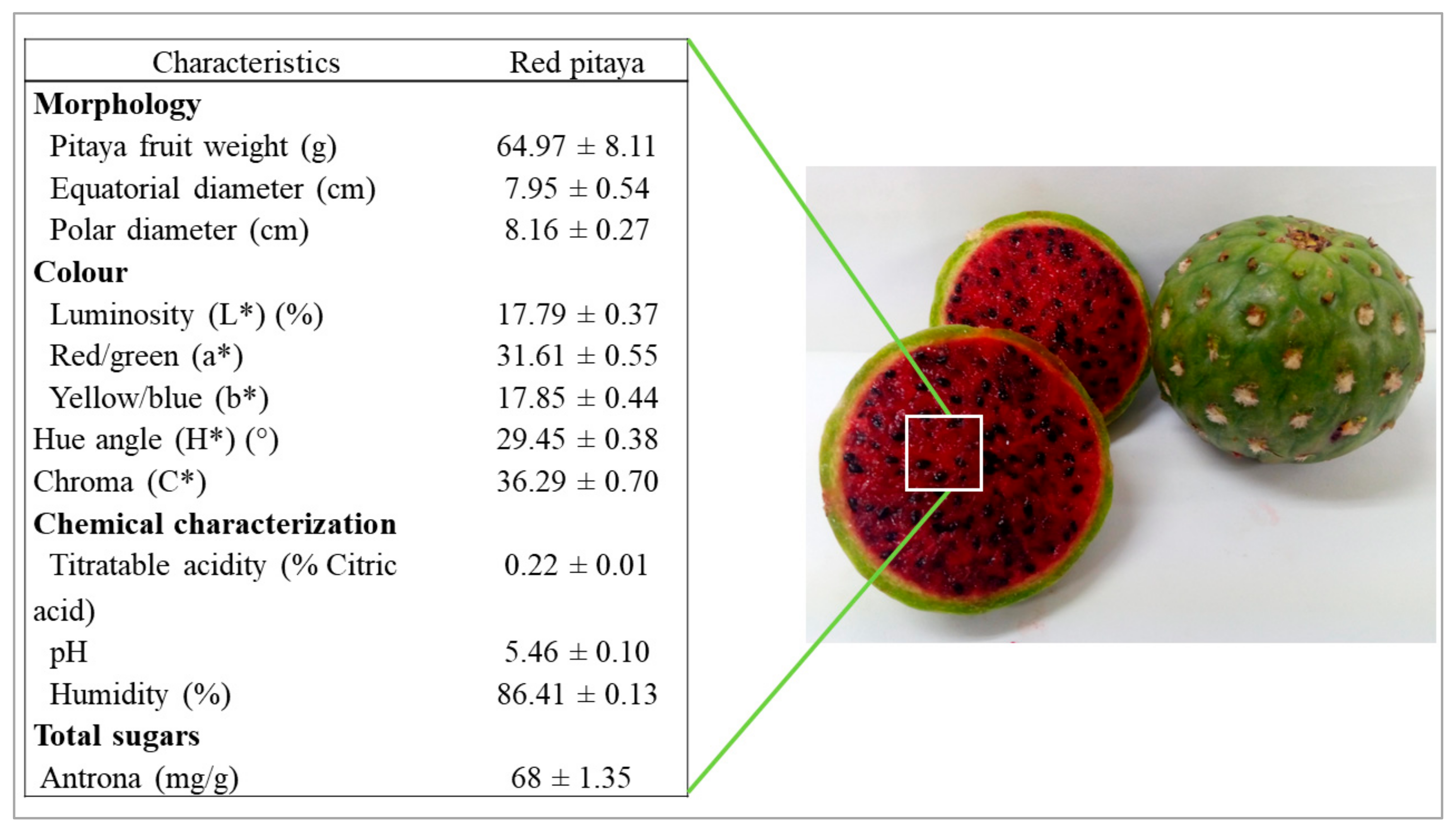

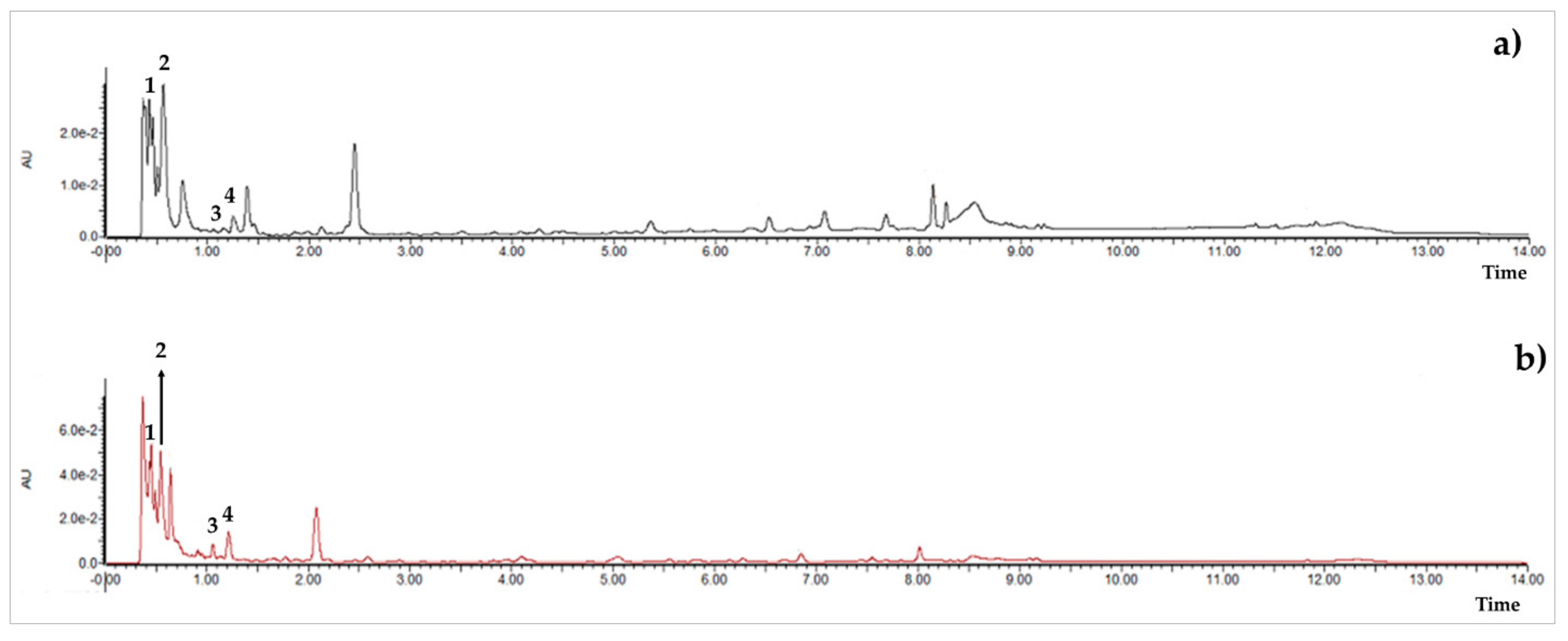
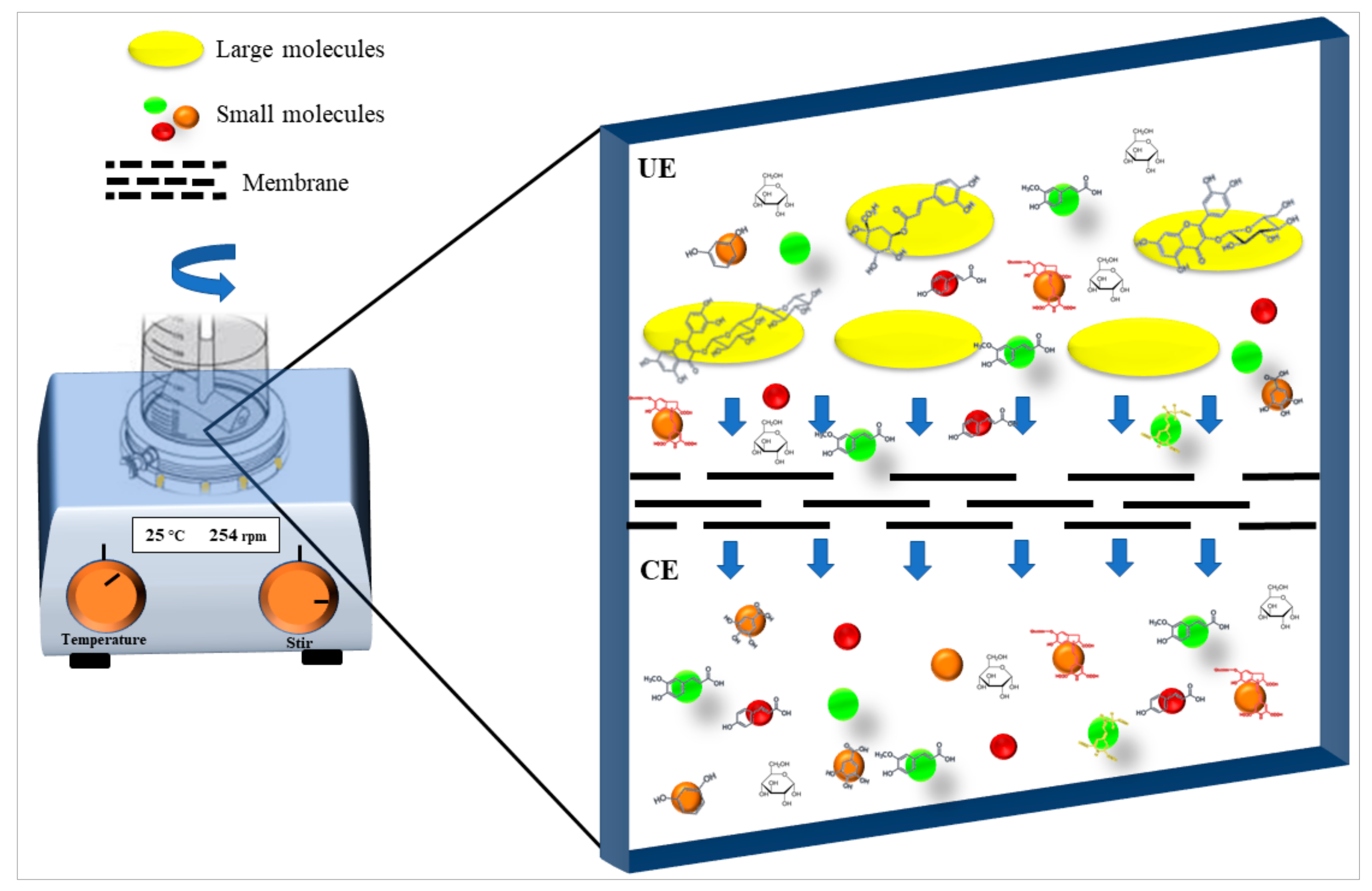
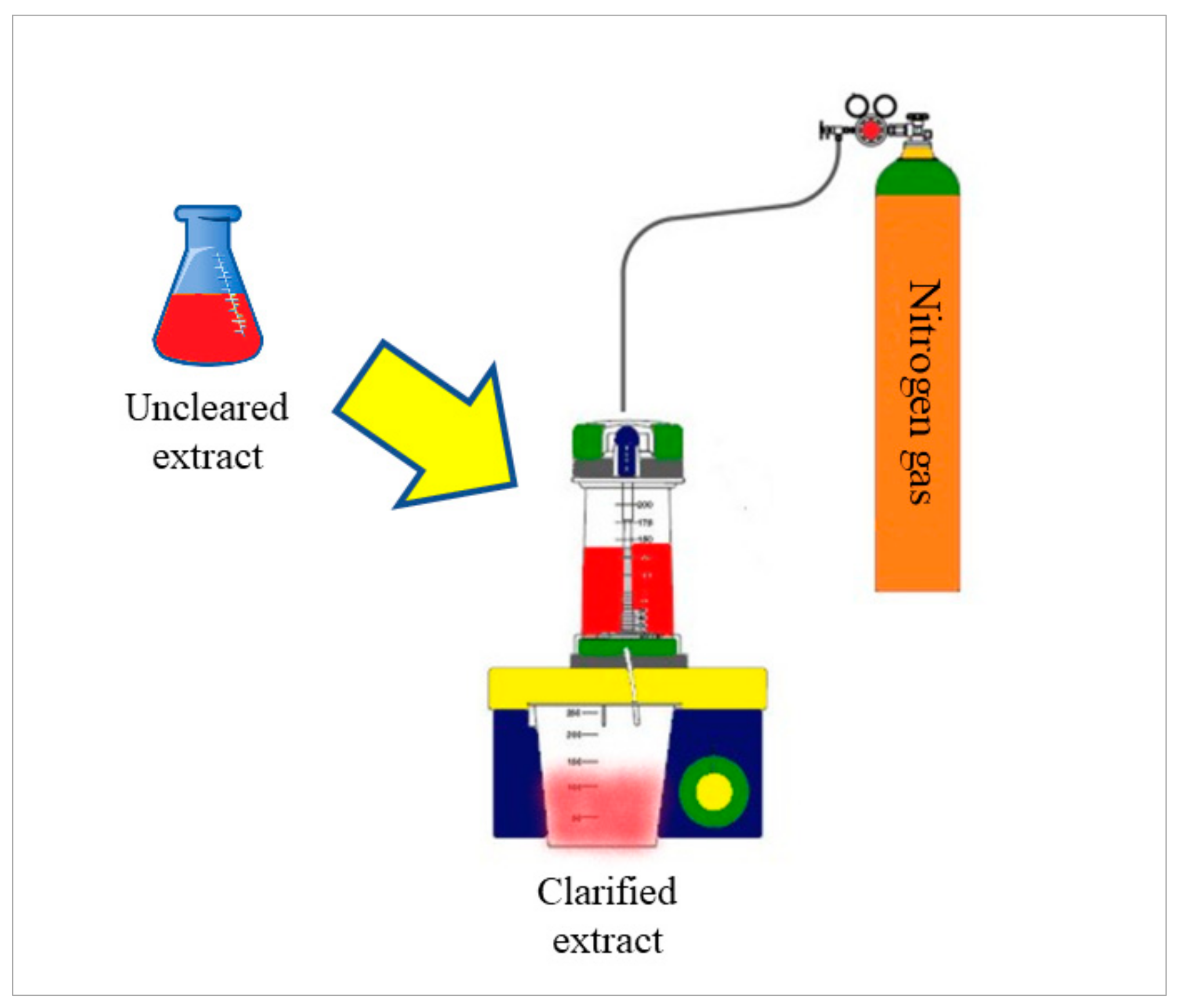
| Phytochemical | UE | CE | |
|---|---|---|---|
| Phenols (mg GAE/g) | 13.89 ± 0.75 a | 20.70 ± 0.81 b | |
| Betalains (mg/g) | Betacyanins | 0.94 ± 0.15 a | 1.17 ± 0.27 a |
| Betaxanthins | 1.16 ± 0.30 a | 1.37 ± 0.41 a | |
| IC50 (mg/mL) | Uncleared Extract | Clarified Extract | |
| DPPH· | 8.9 a | 5.6 c | |
| ABTS·+ | 3.0 b | 1.8 d |
| Peak | Chemical Structure | MF | MM | m/z (M + H)+ | m/z (M-H)− | UE (Rt) | CE (Rt) | |
|---|---|---|---|---|---|---|---|---|
| Phenolic compounds | ||||||||
| 1 | Ferulic acid |  | C10H10O4 | 381 | 382 | 380 | 0.43 | 0.45 |
| 2 | Gallic acid | 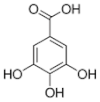 | C7H6O5 | 170 | 171 | 169 | 0.56 | 0.56 |
| 3 | Resorcinol |  | C6H6O2 | 110 | 111 | N.D. | 1.15 | 1.15 |
| 4 | Catechin | 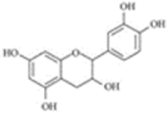 | C15H14O6 | 290 | 291 | 289 | 1.21 | 1.25 |
| 5 | Caffeic acid |  | C9H8O4 | 180 | 181 | N.D. | 2.45 | N.D. |
| 6 | p-coumaric acid |  | C9H8O3 | 164 | 165 | 163 | 4.19 | 4.19 |
| 7 | Rutin |  | C27H30O16 | 610 | 611 | 609 | 6.52 | N.D. |
| 8 | Isorhamnetin |  | C16H12O7 | 316 | 317 | N.D. | 8.14 | N.D. |
| 9 | Quercetin |  | C15H10O7 | 302 | 303 | N.D. | 9.23 | N.D. |
| 10 | Caffeoylquinic acid | 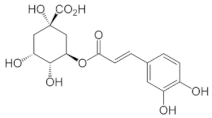 | C16H18O9 | 354 | N.D. | 353 | 11.31 | N.D. |
| 11 | Glycosylated quercetin |  | C21H20O12 | 464 | 465 | N.D. | 11.90 | N.D. |
| Phytochemical | Coeficientes de Correlación (r) | ||||
|---|---|---|---|---|---|
| UE | CE | ||||
| * ABTS | * DPPH | * ABTS | * DPPH | ||
| Phenolic compounds | 0.983 | 0.997 | 0.922 | 0.988 | |
| Betalains | Betacyanins | 0.982 | 0.992 | 0.902 | 0.997 |
| Betaxanthins | 0.991 | 0.994 | 0.941 | 0.991 | |
© 2020 by the authors. Licensee MDPI, Basel, Switzerland. This article is an open access article distributed under the terms and conditions of the Creative Commons Attribution (CC BY) license (http://creativecommons.org/licenses/by/4.0/).
Share and Cite
Castro-Enríquez, D.D.; Montaño-Leyva, B.; Del Toro-Sánchez, C.L.; Juárez-Onofre, J.E.; Carvajal-Millán, E.; López-Ahumada, G.A.; Barreras-Urbina, C.G.; Tapia-Hernández, J.A.; Rodríguez-Félix, F. Effect of Ultrafiltration of Pitaya Extract (Stenocereus thurberi) on Its Phytochemical Content, Antioxidant Capacity, and UPLC-DAD-MS Profile. Molecules 2020, 25, 281. https://doi.org/10.3390/molecules25020281
Castro-Enríquez DD, Montaño-Leyva B, Del Toro-Sánchez CL, Juárez-Onofre JE, Carvajal-Millán E, López-Ahumada GA, Barreras-Urbina CG, Tapia-Hernández JA, Rodríguez-Félix F. Effect of Ultrafiltration of Pitaya Extract (Stenocereus thurberi) on Its Phytochemical Content, Antioxidant Capacity, and UPLC-DAD-MS Profile. Molecules. 2020; 25(2):281. https://doi.org/10.3390/molecules25020281
Chicago/Turabian StyleCastro-Enríquez, Daniela D., Beatriz Montaño-Leyva, Carmen L. Del Toro-Sánchez, Josué E. Juárez-Onofre, Elizabeth Carvajal-Millán, Guadalupe A. López-Ahumada, Carlos G. Barreras-Urbina, José A. Tapia-Hernández, and Francisco Rodríguez-Félix. 2020. "Effect of Ultrafiltration of Pitaya Extract (Stenocereus thurberi) on Its Phytochemical Content, Antioxidant Capacity, and UPLC-DAD-MS Profile" Molecules 25, no. 2: 281. https://doi.org/10.3390/molecules25020281
APA StyleCastro-Enríquez, D. D., Montaño-Leyva, B., Del Toro-Sánchez, C. L., Juárez-Onofre, J. E., Carvajal-Millán, E., López-Ahumada, G. A., Barreras-Urbina, C. G., Tapia-Hernández, J. A., & Rodríguez-Félix, F. (2020). Effect of Ultrafiltration of Pitaya Extract (Stenocereus thurberi) on Its Phytochemical Content, Antioxidant Capacity, and UPLC-DAD-MS Profile. Molecules, 25(2), 281. https://doi.org/10.3390/molecules25020281






